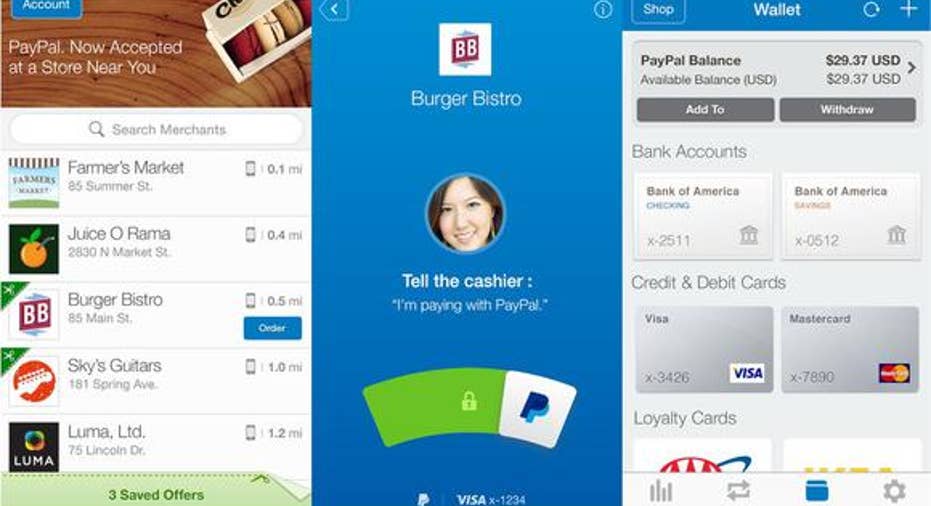5 Things Investors Should Know About Mobile Payments

Many tech companies have expanded into the mobile payments market, with the goal of replacing physical credit cards with smartphone apps. PayPal and Square were early movers in the market, but tech giants Apple , Samsung , Alphabet 's Google, and others have since followed their lead.
Source: Google.
With all these players aiming at the same market, it can be hard for investors to isolate the key facts and figures from all the market noise. To get started, let's discuss five key facts investors must understand about the mobile payments market.
Apple's sweetheart dealWhen Apple launched Apple Pay in late 2014, it convinced credit card companies to pay it a 0.15% cut of each transaction. This was considered a game-changing victory, because card companies didn't pay other payment services like PayPal, Square, and Google Wallet, which generate revenue by taking a 2% to 3% cut of the merchant's sale. Apple Pay, however, was processed just like a credit card payment with a basic 1% to 3% interchange fee.
Google tried to secure a similar "sweetheart" deal for Android Pay, but credit companies subsequently introduced tokens which prevented third-party services from charging them for transactions. As a result, Google's rival platform doesn't generate any meaningful revenue yet.
Apple Pay. Source: Apple.
The interchange fee conflictBusinesses generally hate interchange fees, which whittle away at their profits. Since Apple and Android Pay payments are basically processed as credit card payments, several leading retailers led by Wal-Mart tried to establish their own mobile payments network not tethered to credit card companies.
That system, CurrentC, sends payments through an older platform known as an automated clearinghouse -- which is slower, but much cheaper. To promote the use of CurrentC, Wal-Mart and other retailers intentionally blocked the use of Apple and Android Pay on their terminals. But ironically, Wal-Mart subsequently launched its own mobile payment platform -- which is compatible with all credit cards and debit cards -- late last year. Samsung also notably found a way to bypass restrictions on NFC payments, cleverly emulating a card swipe by generating a magnetic field with its newer phones.
The payments standard conflictMobile payment systems still use a wide variety of technologies. PayPal was a big proponent of using Bluetooth beacons to automatically sync with in-store mobile devices for payments and promotions. Square and Google generally favored cloud-based solutions which pulled synchronized payment data from the Internet.
But the key problem with both strategies is that they required businesses to buy Bluetooth beacons and Wi-Fi routers. Several of Square's POS solutions also required the purchase of a tablet, a smartphone, and other peripherals.
However, Apple supported the use of simple NFC (near-field communications) chips instead, which were identical to those found in most modern credit cards. This meant that most retailers could accept Apple Pay on their existing NFC terminals, instead of buying new equipment and altering their checkout processes.
PayPal's mobile app. Source: iTunes.
It's too early to declare NFC the winner in this battle, but Google's introduction of the NFC-enabled Android Pay, Square's launch of Apple Pay-compatible terminals, and PayPal's plans to add NFC support later this year all suggest thatit's becoming the dominant standard.
Market growth potentialDespite those conflicts, research firm Future Markets Insights predicts that the amount of mobile payment transactions worldwide will rise from $392 billion in 2014 to $2.85 trillion in 2020. However, investors should note that mobile payment processors only take a tiny percentage of each transaction, so the actual revenue growth potential is significantly lower.
Piper Jaffray, which believes that 10% to 20% of iPhone users activelyuse Apple Pay, estimates that the service will generate about $310 million in revenue this year -- equivalent to just 0.1% of the tech giant's projected revenue. PayPal's revenues (which also come from desktop sites) are expected to rise 15% to $10.7 billion this year, while Square's are expected to grow 23% to $1.6 billion.
Reinventing the wheelA constant criticism of the mobile payments industry is that companies are trying to reinvent the wheel. Credit cards made life easier for consumers, who no longer had to carry cash or write checks, but most mobile payment apps seem to be designed with the companies' interests (growing ecosystems, mining data, or taking a cut of payments) in mind.
There's simply not much incentive for consumers to use a phone or smartwatch to pay when they can just swipe a card, which doesn't experience software glitches or run out of power. That's likely why Apple Pay usage remains tepid -- InfoScout reported that 79% of iPhone users and 74% of Android users paid with regular credit cards during last year's Black Friday.
The key takeawayMobile payments are a growing market, but investors should have realistic expectations about how much revenue these services can actually generate. Until people are willing to leave their credit cards at home and completely use smartphones to pay, the market could remain a niche one which appeals more to tech enthusiasts than mainstream consumers.
The article 5 Things Investors Should Know About Mobile Payments originally appeared on Fool.com.
Suzanne Frey, an executive at Alphabet, is a member of The Motley Fool's board of directors. Leo Sun has no position in any stocks mentioned. The Motley Fool owns shares of and recommends Alphabet (A shares), Alphabet (C shares), Apple, and PayPal Holdings. Try any of our Foolish newsletter services free for 30 days. We Fools may not all hold the same opinions, but we all believe that considering a diverse range of insights makes us better investors. The Motley Fool has a disclosure policy.
Copyright 1995 - 2016 The Motley Fool, LLC. All rights reserved. The Motley Fool has a disclosure policy.



















